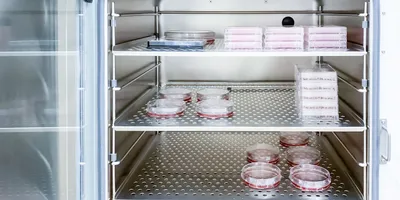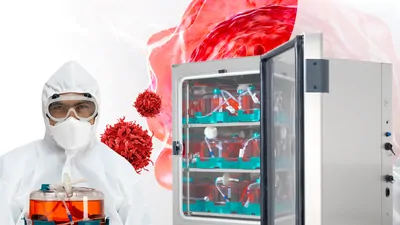When a CO₂ incubator is successful in culturing cells and maintaining their health, this core laboratory instrument enables significant advancements across various fields of life science research. Cell culture incubators play a crucial role in drug discovery testing, where healthy cells serve as baseline test subjects for evaluating drug candidates, giving early indications of efficacy and potency. In biochemical, genetic, and cell function research, healthy cells are essential for studying genetic modifications, such as CRISPR, and understanding fundamental cellular processes, including signaling, metabolism, and immune responses.
Cellular biology is used across life sciences, from oncology to neurology to parasitology, to help us understand systemic effects. Additionally, in infectious disease research, healthy cultured cells are crucial for vaccine testing, drug screening, and examining pathogen-host interactions.
Given the sensitivity and complexity of these research applications, laboratories must select CO2 incubators that consistently support robust, reproducible, and healthy cell growth. However, not all CO2 incubators are created equally, and when the incubator is not performing well, the quality of the cells within and subsequent analyses are all in question.
The critical role of precise temperature and CO2 regulation
Today’s cultured cells include immune, stem, neural, and primary cells, which are exquisitely responsive and sensitive due to environmental factors. The inherent biological complexities of these cells make life science research a highly technical process, with tiny changes having downstream effects. Innovations in detection mean that life scientists are more aware of how culture conditions affect cellular responses. Because these sensitive cells are so reactive, researchers must limit variables as much as possible. The CO2 incubator must create an optimal environment for cells to thrive while restricting contamination. This means creating a stable a uniform environment by controlling variability in culture conditions. A culture temperature of even 1°C for only a few hours can harm or even kill some cell types. Temperatures that are too cold for too long result in lagging growth and gene expression, which can affect experimental interpretation. Any temperature variability can decrease metabolic function, inhibit cell growth, or kill a cell altogether. When CO2 concentration is not properly paired with growth medium buffering capacity, the culture pH can shift from neutral 7.4 to too acidic or too basic. When the pH is off, cellular morphology and metabolism are affected, and cells may experience stress or even death.
An in-chamber circulating fan that supports active airflow throughout the entire chamber is critical to supporting uniformity throughout the chamber, from top to bottom and side to side. Without active air circulation, heat rises such that cells on the top shelf may be in a higher temperature than those near the bottom. At least as important, CO2 gas is heavier than air, so without active airflow, it sinks. With more than a few culture vessels in an incubator chamber, passive convection breaks down and a set CO2 concentration can range from 4.2 percent near the chamber ceiling to 7.2 percent near the bottom.
For hypoxic culturing using nitrogen gas to drive out oxygen, active airflow is also required. Nitrogen gas is lighter than air, so it rises. Since many cellular processes, including differentiation, are controlled by oxygen, cells at the top of the incubator can exhibit very different characteristics. Large experiments can yield results that are difficult to interpret due to variability, even with good controls included.
Lab Quality Management Certificate
The Lab Quality Management certificate is more than training—it’s a professional advantage.
Gain critical skills and IACET-approved CEUs that make a measurable difference.
Minimizing contamination risks with enhanced humidity control and real-time monitoring
Lab managers and technicians need CO2 incubators that can support their most demanding and critical applications, from research to discovery and development to production scale-out and automation. When selecting CO2 incubators, features like consistent airflow and proven sterilization technology can help ensure cells undergo homogenous growth without contamination.
For research where reliable, reproducible sterilization is required, an automated sterilization system should be independently verified by a trusted commercial test laboratory, with tests showing sterilization using heat-resistant biological indicators according to international standards. For 24/7 contamination control, a CO2 incubator that features in-chamber HEPA filtration can support thriving cells when the unit is in active use. Again, this method should be tested to determine time to ISO Class 5 cleanroom conditions. A model that rapidly achieves ISO Class 5 air quality in five minutes or less will help ensure cells are optimally protected and maintained.
Other technologies labs should look for in their CO2 incubators include a protected, integrated humidity reservoir and in-chamber sensors for CO2, temperature and optional O2. These help provide fast reactions to maintain desired conditions. Some incubators position sensors in an external electronics chamber and remove air samples to test. The air sample tubing is very difficult to clean or disinfect, running the risk of being an ongoing reservoir of microbial contaminants.
Scaling up to meet changing demands
It’s also essential to look for CO2 incubators that can support a variety of applications as development demands evolve. Such evolutions sometimes need to happen quickly, whether it’s moving to the next stage of therapy scale-up or changing course to focus on a new application. Features that help make this transition as smooth as possible, while still supporting an optimal environment for cell growth with minimal contamination risks, are critical.
Standardizing processes early on with CO2 incubators that offer options for scaling up research, including stackable incubators, larger models, increased shelving options, and support for heavy vessels like bioreactors used in cell therapy manufacturing, can help make research and development changes more seamless.
Supporting human health and safety
As well as protecting the research inside, a well-designed CO2 incubator should be easy to open and close, and parts should be removable without tools. Shelves should slide out smoothly, with designs that prevent tipping so that cultures aren’t accidentally dropped. A large, clear touchscreen display should allow viewing of conditions from a distance and must work even when wearing double gloves as is the case when working with pathogens. Because laboratories often include international teams, the controls should allow different languages and be intuitive for easy training. For record-keeping, performance data and error codes should be logged and downloadable to any PC or laboratory information management system, without requiring specialized software. When two incubators are stacked, users should be assured that there is no risk of tipping that could put personnel in danger.
Supporting robust workflows
Cultured cells are the foundation for a significant portion of life science research, but none of it would be possible without CO2 incubators, which, when properly designed, create the perfect environment for cells to grow and be studied. Life science research is an incredibly vast field that is ever-evolving, with new discoveries requiring technology that can keep pace with them and help advance the field. Labs need to select CO2 incubators that can help researchers tackle evolving applications while also prioritizing quality cell growth, consistency, and contamination control.












